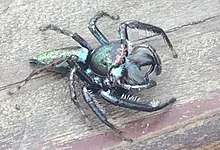Ascyltus
Ascyltus are a genus of jumping spiders in the family Salticidae that was first described by Ferdinand Anton Franz Karsch in 1878.[2] As of 2019, this Genus contained 10 species. [3] The Ascyltus spiders utilize their vision in courtship, hunting, and navigation. Ascyltus are typically large to medium sized Salticids and often move relatively slow. However, they are capable of agile jumps when moving, hunting, or to avoid predators. They have well developed book lungs and tracheal systems, and they are capable of utilizing both systems (bimodal breathing). Ascyltus have four pairs of eyes, with the anterior median pair being the most prominent. One distinguishable characteristic of the Ascyltus include their antero-lateral carapace, which is iridescently colored.[4]
| Ascyltus | |
|---|---|
 | |
| Scientific classification | |
| Kingdom: | Animalia |
| Phylum: | Arthropoda |
| Subphylum: | Chelicerata |
| Class: | Arachnida |
| Order: | Araneae |
| Infraorder: | Araneomorphae |
| Family: | Salticidae |
| Genus: | Ascyltus Karsch, 1878[1] |
| Type species | |
| A. pterygodes (L. Koch, 1865) | |
| Species | |
|
10, see text | |
Distinguishing characteristics
Ascyltus are relatively large to medium sized salticids. Distinguishable from other Pacific salticids by their antero-lateral carapace, which is iridescently colored. In addition to being iridescently colored, their antero-lateral carapace is typically widened even at a juvenile age. Like other members of the Salticidae, Ascyltus have four pairs of eyes in three rows. The anterior median eyes are noticeably more prominent than the others. Palpal structures are similar among all Ascyltus species. [4]
Size
- Males average 13-19 millimeters
- Females average 16-20 millimeters
Geographic distribution
The majority of Ascyltus species live in Oceania, having a widespread distribution across the Pacific islands. Some Ascyltus have also been found in the Hawaiian islands.[5]
Diet
Ascyltus are carnivorous, so their diet mainly consists of insects around the tropical region. They capture the majority of their food by stalking or hunting prey. This includes many flies, crickets, and small grasshoppers.
Hunting
The Ascyltus jumping spider relies on visual stimuli when catching prey. The anterior-lateral eyes function to track moving objects. The anterior-median eyes are essential for the stalking of prey because of their telescopic abilities.[6] Ascyltus spiders typically employ one of three set of responses to catch prey. The responses are a set of motor movements as follows: Alignment Pursuit - follow, run, stalk; Orientation - alert, swivel; and Capture - crouch and jump. The distance separating the spider from its prey are the determining factor in the response pattern used. [7]
Species
As of June 2019 it contains ten species, found only in Oceania, on the Pacific Islands, and Sulawesi:[1]
- Ascyltus asper (Karsch, 1878) – Australia (New South Wales), New Caledonia
- Ascyltus audax (Rainbow, 1897) – Tuvalu (Funafuti)
- Ascyltus divinus Karsch, 1878 – Australia (Queensland), Fiji
- Ascyltus ferox (Rainbow, 1897) – Tuvalu (Funafuti)
- Ascyltus lautus (Keyserling, 1881) – New Guinea, Samoa
- Ascyltus minahassae Merian, 1911 – Indonesia (Sulawesi)
- Ascyltus opulentus (Walckenaer, 1837) – Tonga
- Ascyltus pterygodes (L. Koch, 1865) (type) – Pacific Is.
- Ascyltus rhizophora Berry, Beatty & Prószyński, 1997 – Fiji
- Ascyltus similis Berry, Beatty & Prószyński, 1997 – Fiji, Samoa
References
- Gloor, Daniel; Nentwig, Wolfgang; Blick, Theo; Kropf, Christian (2019). "Gen. Ascyltus Karsch, 1878". World Spider Catalog Version 20.0. Natural History Museum Bern. doi:10.24436/2. Retrieved 2019-07-05.
- Karsch, F. (1878). "Diagnoses Attoidarum aliquot novarum Novae Hollandiae collectionis Musei Zoologici Berolinensis". Mittheilungen des Münchener Entomologischen Vereins. 2: 22–32.
- "Species list for Ascyltus".
- Berry, James (15 April 2020). "Salticidae of the Pacific Islands II". Journal of Arachnology. 2: 109–136. JSTOR 3705640.
- Richardson, Barry (2006). "Distributional patterns of jumping spiders (Araneae: Salticidae) in Australia". Journal of Biogeography. 33 (4): 707–719. doi:10.1111/j.1365-2699.2005.01405.x.
- Forster, Lyn (30 January 2012). "Visual mechanisms of hunting behaviour in Trite planiceps, a jumping spider (Araneae: Salticidae) Lyn". New Zealand Journal of Zoology. 6: 73–93. doi:10.1080/03014223.1979.10428351.
- Forster, Lyndsay (30 March 2010). "A qualitative analysis of hunting behaviour in jumping spiders (Araneae: Salticidae)". New Zealand Journal of Zoology. 4: 51–62. doi:10.1080/03014223.1977.9517936.